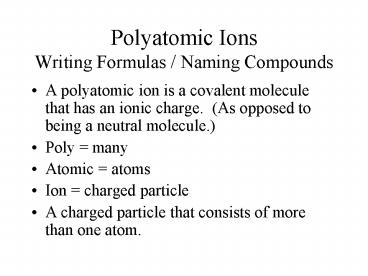Polyatomic Ions Writing Formulas / Naming Compounds - PowerPoint PPT Presentation
1 / 13
Title:
Polyatomic Ions Writing Formulas / Naming Compounds
Description:
Polyatomic Ions Writing Formulas / Naming Compounds A polyatomic ion is a covalent molecule that has an ionic charge. (As opposed to being a neutral molecule.) – PowerPoint PPT presentation
Number of Views:641
Avg rating:3.0/5.0
Title: Polyatomic Ions Writing Formulas / Naming Compounds
1
Polyatomic IonsWriting Formulas / Naming
Compounds
- A polyatomic ion is a covalent molecule that has
an ionic charge. (As opposed to being a neutral
molecule.) - Poly many
- Atomic atoms
- Ion charged particle
- A charged particle that consists of more than one
atom.
2
Polyatomic Ions
- Examples
- Sulfate SO4-2
- Nitrate NO3-1
- Phosphate PO4-3
- Chlorate ClO3-1
- Carbonate CO3-2
- Notice the ending has changed to ate.
3
Writing Formulas
- Sodium Sulfate
- Write the formula for the metal. Add the
oxidation number from the periodic table. - Na1
- Write the formula for the polyatomic ion from the
ion chart. Add its oxidation number. - SO4-2
4
Sodium SulfateNa 1 SO4-2
- Determine the common factor of the two oxidation
numbers. In this case, 2. - Decide how many of each ion is needed to equal
the common factor. In this case, 2 sodium ions
and 1 sulfate ion. - Write these numbers as the subscript for each
ion. - Na2SO4
5
Calcium Phosphate
- Write the formula for the metal. Add the
oxidation number from the periodic table. - Ca2
- Write the formula for the polyatomic ion from the
ion chart. Add its oxidation number. - PO4-3
6
Calcium PhosphateCa 2 PO4 -3
- Determine the common factor of the two oxidation
numbers. In this case, 6. - Decide how many of each ion is needed to equal
the common factor. In this case, 3 calcium ions
and 2 phosphate ions. - Write these numbers as the subscript for each
ion. - Ca3(PO4)2
- Notice that the polyatomic ion must be placed in
parenthesis or, instead of 2 phosphate ions, you
would have 42 Oxygen atoms and 1 Phosphorus
atom. Ca3PO42
7
Naming Compoundsw/ Polyatomic Ions
- KClO3
- Write the name of the metal.
- Potassium
- Write the name of the polyatomic ion from the ion
chart. - Chlorate
- Name the compound.
- Potassium Chlorate
8
Mg3(SO4)2
- Name the metal.
- Magnesium
- Name the polyatomic ion from the ion chart.
- Sulfate
- Name the compound.
- Magnesium Sulfate
9
Some Additional Examples
- Calcium Hydroxide
- Ca2 OH-1
- The least common factor is 2. Therefore, 1
calcium ion will bond with 2 hydroxide ions to
form a neutral compound. - Ca(OH)2
- If you omitted the parenthesis, you would not
have 2 hydroxide ions. Instead you would have 2
hydrogen atoms and one oxygen atom. CaOH2
10
Try these
- Write names for the following compounds.
- CaCO3
- Al2(SO4)3
- Ca(ClO3)2
- K3PO4
- Mg(OH)2
11
Answers
- Calcium carbonate
- Aluminum sulfate
- Calcium chlorate
- Potassium phosphate
- Magnesium hydroxide
12
Now, these!
- Write formulas for the following compounds.
- Lithium sulfate
- Calcium acetate
- Aluminum nitrate
- Magnesium phosphate
- Sodium carbonate
13
Answers
- Li2SO4
- Ca(C2H3O2)2
- Al(NO3)3
- Mg3(PO4)2
- Na2CO3































